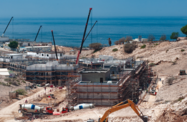A programme by the Omani government to pour billions into infrastructure to help support long-term economic diversification is benefiting the Sultanate’s construction sector, which will likely see its order books filled for years to come.
According to Paula Boast, a partner at the Bahrain office of legal firm Trowers & Hamlins, which has advised on a number of construction projects in the Sultanate, prospects for the building industry are encouraging.
“The message coming out of Oman is positive,” she told a construction industry seminar on November 10. “There is a good mix of active projects and projects coming on-line. It is good to note that the focus has been on key areas like infrastructure – social, economic, and civil – tourism and utilities and support. Infrastructure is a necessity, it drives commerce and industry, promotes economic growth and will put Oman on the international map.”
The construction sector is expected to grow by 6.3% this year, according to Boast, significantly faster than the 5.1% rise in overall GDP that the IMF has projected for Oman in 2013.
Infrastructure the driving force
It is in infrastructure where the Omani government is intending to make its largest investments over the coming years, with some $56bn worth of projects scheduled to be carried out between this year and 2017, and a further $56bn worth of developments through 2022.
The transport sector is set to be the biggest beneficiary of the construction push, with the 2244-km national rail grid the cornerstone of the infrastructure programme. Construction of the $15.6bn network, which will link up several major industrial hubs, as well as provide a connection to the planned GCC rail system, is expected to begin in the last quarter of 2014 and be completed in 2018.
Among the other major transport and logistics projects set to be built or completed over the coming years are a $5.2bn expansion of the Muscat and Salalah airports, and a further $3.2bn on road upgrades, while billions more are to be spent on developing the ports of Duqm and Sohar over the next few years. The hydrocarbons sector will also see increased investments, with high levels of spending intended to boost production at existing fields and bring new reserves on-line.
Though many of these projects will see work awarded to foreign contractors, some will be co-operating with local firms, with Omani construction companies also in line to win secondary contracts on the large-scale developments.
The higher flow of projects being pumped out through the capital works pipeline will also serve to benefit the construction materials segment of the industry. In anticipation of a rise in demand, the Sultanate’s two leading cement producers have announced plans to expand their facilities, with both Oman Cement and Raysut Cement looking to increase output by the end of the year.
Controlling costs and delays
Oman has experienced delays in some big infrastructure projects, including the on-going expansion of its airports. Increasing the workload could stretch the industry’s capacities and place heavy demands on materials suppliers, creating the possibility of further holdups and additional costs.
Moreover, with construction across the Gulf region regaining momentum after the slow-down in the wake of the global financial crisis, materials and labour costs will likely start to climb, fuelling inflation within the industry.
Despite this risk, Oman’s construction sector should be on an upward path for the better part of the next decade, with the state’s spending likely to build further growth in the wider economy.
Follow Oxford Business Group on Facebook, Google+ and Twitter for all the latest Economic News Updates. Or register to receive updates via email.

